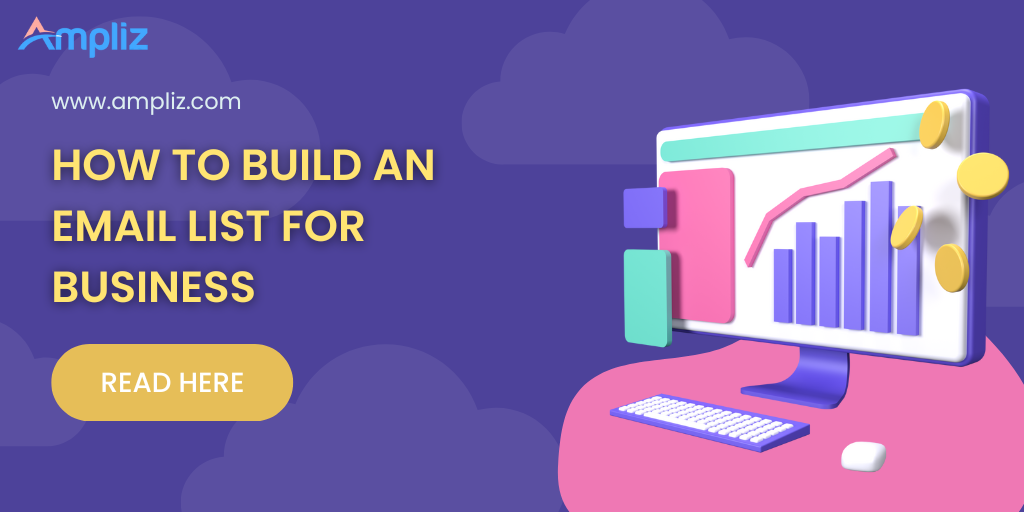In this digital age, do you know what is your biggest treasure? Email list of your target audience. Yes, although you must have thousands of social media followers, they are not your audience, they are the audience of that social media channel. What if, suddenly social media channels get banned? Or if your account gets hacked?
You will lose all your followers.
Where else if you have your audience’s email address, you have your own set of audience. An email list allows you to have segmented and personalized conversations with your audience.
Email marketing has the highest conversion rate. To leverage this, you must have an engaged email list.
Want to know how to build an email list?
Then, this blog is for you. Let’s discuss some tips to build your email list.
9 best way to build an email list
If you’ve never built an email list before or run out of creative ideas on how to do so, here are nine proven tricks that will save your time.
1. Choose the right email marketing software
The motive behind collecting the email addresses of your target audience is to send emails frequently. And when it comes to sending emails to your target audience you must rely upon a trustworthy email list. Not only the quality of your email list or the content of your email, but the quality of your email marketing tool makes a big difference.
It’s your chosen email marketing tool that helps you efficiently manage and organize your growing email list. Choosing the right tool helps you build your mailing list from scratch and capitalize on the full potential of email marketing.
Some of the best email marketing software are
- Hubspot
- Mailchimp
- Bravo
- Zoho campaigns
- MailerLite
2. Create a compelling incentive
Why would people share their contact information with you? You have to give them some reason. If you place only a sign-up form on your website without giving them anything in return, you will get very minimal sign-ups.
To get more sign-ups you have to give them some incentives, and for that, you can think of creating
- E-book
- A Checklist summarizing steps from a blog post
- A cheat sheet
- A coupon
- A webinar registration
- A template or worksheet
- A free course or email sheet
Offering anyone of these or a combination of these compels your visitor to sign up and you will get the best result.
3. Optimize your call-to-action
Write a CTA that compels your visitors to take action. It should be used at the right place and right time. You can craft an effective CTA by using the following tips
- Choose the right action verb
- Use power words and emotional triggers
- Create urgency and scarcity
- Highlight benefits and value proposition
- Include numbers if relevant
- Test and optimize the CTA
Wrtiting compelling CTA is one of the best ways to build an email list and broaden your horizons.
4. Place your sign-up form strategically
Placing the sign-up form in the right place is important. Choose the place in such a way that it looks natural and it should not spoil the user experience. It should be also at the noticeable place.
The recommended places to place your sign-up forms are
- Top of the sidebar
- Top header
- After the post
- Footer
- Pop Box
5. Leverage your social media accounts
The way so many businesses have grown their email list with the help of social media is commendable. Social media is a valuable tool for growing an email list. By integrating social media and email marketing, you can leverage the strengths of both channels to create a holistic marketing strategy. Here are some ways you can use social media to grow your email list:
Create a Lead Magnet: Offer a valuable resource, such as an e-book or template, in exchange for email addresses. You can promote the lead magnet on your social media channels to drive followers to a landing page where your visitors can sign up to receive it.
Host a Contest or Giveaway: Run a contest or giveaway on social media that requires followers to sign up for your email list to enter.
Use Social Proof: Share testimonials, reviews, or user-generated content on your social media channels to demonstrate the value of being on your email list.
Add Social Media Elements to Your Emails: Include social media buttons, icons, links, or hashtags in your emails to make it easy for subscribers to follow, share, or interact with your social media accounts.
Encourage User-Generated Content: Encourage your followers to create and share content about your brand on social media, and invite them to join a community, such as a Facebook group, where they can engage with your brand and other customers.
It’s important to note that while social media can be a powerful tool for growing your email list, it’s also essential to deliver valuable content and engage with your subscribers to keep them interested in your brand.
6. Ask visitors to opt in at check-out
Opting in at checkout can help grow an email list by allowing customers to voluntarily subscribe to the list during the checkout process.
You can do this by including a checkbox or opt-in form that is simple and straightforward, and by avoiding asking for too much information.
You can also incentivize sign-ups by offering a discount or other special offers can also be effective. A/B testing can be used to optimize email opt-in rates over time.
Email opt-ins are a great way to promote sales and special offers to subscribers, and can be personalized through segmentation.
You can also use Pop-ups, offering first-purchase discounts, and optimizing opt-ins through timing, CTAs, and placement are other effective strategies you can use to build mailing list.
7. Create viral content
To run a viral content campaign to grow an email list, you can use the following strategies:
Create Engaging Content: Develop high-quality, shareable content that has the potential to go viral. Distribute it on platforms like YouTube, TikTok, and Facebook to reach a larger audience.
Offer Incentives: You can provide a free resource or incentive, such as an ebook, template, or tool, in exchange for email addresses. Promote this lead magnet on social media to attract new subscribers.
Host Giveaways and Contests: You can run viral giveaways or contests that require participants to sign up for your email list. This can help you quickly acquire a large number of new subscribers.
Use Lead Magnets: Leverage lead magnets, such as exclusive content or offers, to entice social media followers to join your email list. You can promote these lead magnets through viral content on platforms like TikTok.
By combining these strategies with a strong call to action and compelling content, you can increase the likelihood of your content going viral and attract more subscribers to your email list.
8. Create more landing pages
Creating more landing pages can help in growing an email list by providing targeted opportunities for visitors to subscribe. Here are some ways in which landing pages can be used to build an email list:
Offer-specific pages: Each landing page can be tailored to a specific offer, such as a discount, ebook, or webinar, making it more likely that visitors will subscribe in exchange for the offer.
Segmentation: Landing pages can be used to segment visitors based on their interests or behavior, allowing for more targeted and effective email marketing.
A/B testing: By creating multiple landing pages and testing different elements, such as copy, design, and calls to action, it’s possible to optimize the performance of the pages and increase conversion rates.
Pre-launch pages: For businesses launching a new product or service, a pre-launch landing page can be used to capture the email addresses of interested visitors before the launch.
9. Use a referral program
A referral program can help in growing an email list by leveraging the trust and influence of existing subscribers and customers to attract new subscribers. Here are some ways in which referral programs can be used to grow an email list:
Milestone referral system: A milestone referral system can be used to reward subscribers when they achieve specific referral milestones, incentivizing them to refer others and thereby grow the email list.
Directly ask for referrals: Asking existing subscribers directly to refer their friends and family to the email list can be an effective way to attract new subscribers.
Forward link in marketing emails: Adding a forward link to marketing emails allows subscribers to easily forward the email to their network, thereby expanding the reach of the email list.
Rewards and incentives: Offering rewards and incentives to both the referrer and the new subscriber can motivate existing subscribers to refer others, leading to email list growth.
Identifying top referrers: A referral program can help identify top referrers, who can be rewarded and potentially become partners in further growing the email list.
These are some of the effective ways of creating an engaging email list. These efforts take real effort and time.
The one more way to have your engaged email list is to buy a customized and readymade email list from reliable database providers. You can save a lot of your time and effort and increase the efficiency of conversion, provided they provide you accurate, real-time updated, and compliant email list.
When it comes to finding database selling companies who provide you with accurate, real-time updated, and compliant email lists, you can rely upon Ampliz.
Ampliz provides you 98% accurate, real-time updated, and compliant email address of your target audience. Along with your email address, Ampliz also provides other details of your target audience like location, revenue, number of employees, funding stack, technology stack, and so on.
Conclusion
Email marketing is one of the most cost-effective, revenue-generating, and reliable digital marketing channels. To leverage it you have to take care of email marketing software, email content, and the quality of the email list.
Following the above-mentioned strategy will help you to build an quality email list.



